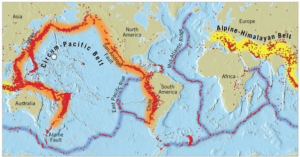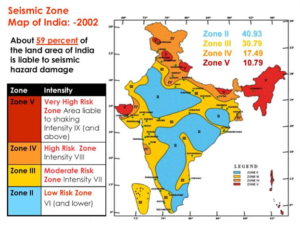Earthquake
Q. Highlight the earthquake distribution in the world. Discuss the vulnerability of India to earthquake-related hazards. (250 Words)
Approach
- Introduce your answer by briefly describing earthquake.
- Discuss the distribution of earthquake in the world.
- Discuss vulnerability of earthquake related hazards in India.
Introduction
An earthquake in simple words is the shaking of the earth. It is a natural event. It is caused due to release of energy, which generates waves that travel in all directions.
The vibrations called seismic waves are generated from earthquakes that travel through the Earth and are recorded on instruments called seismographs.
Types of Earthquakes: Fault Zones, Tectonic Earthquakes, Volcanic Earthquake, Human Induced Earthquakes.
Body
Distribution of Earthquake:
- Circum-Pacific Seismic Belt: The world’s greatest earthquake belt, the circum-Pacific seismic belt, is found along the rim of the Pacific Ocean, where about 81% of our planet’s largest earthquakes occur. It has earned the nickname “Ring of Fire”.The belt exists along boundaries of tectonic plates, where plates of oceanic crust are sinking (or subducting) beneath another plate. Earthquakes in these subduction zones are caused by slip between plates and rupture within plates.
- Mid Continental Belt: The Alpine earthquake belt (mid Continental belt) extends from Europe to Sumatra through the Himalayas, the Mediterranean, and out into the Atlantic. This belt accounts for about 17% of the world’s largest earthquakes, including some of the most destructive one.
- Mid-Atlantic Ridge: The third prominent belt follows the submerged mid-Atlantic Ridge. The ridge marks where two tectonic plates are spreading apart (a divergent plate boundary).Most of the mid-Atlantic Ridge is deep underwater and far from human development.
- India lies in the Alpine earthquake belt which is one of the most destructive belt of earthquakes. Vulnerability of earthquake related hazards in India:
India is prone to earthquakes because:
- The landmass is penetrating into the Eurasian plate, which makes the country prone to earthquakes of moderate to very high intensity.
- Densely populated areas, extensive unscientific constructions and unplanned urbanization have increased risks.
- Regions in Himalayan foothills are vulnerable to liquefaction and landslides due to earthquakes.
- Further, about 59% of India’s land mass is prone to earthquakes of different intensities. The area is classified into four seismic zones:
Zone-V (Very High Risk),
Zone-IV (High Risk),
Zone-III (Moderate Risk),
Zone-II (Low Risk).
As per the current seismic zone map of the country the entire Himalayan belt is considered prone to great earthquakes of magnitude exceeding 8.0; and in a relatively short span of about 50 years, four such earthquakes have occurred: 1897 Shillong (8.7); 1905 Kangra (8.0); 1934 Bihar-Nepal (8.3); and 1950 Assam-Tibet (8.6).
Various scientific publications have warned of the likelihood of the occurrence of very severe earthquakes in the Himalayan region, which could adversely affect the lives of several million people in India.
Conclusion
Today, the vast majority of buildings being built in India, particularly in suburban and rural regions, are not engineered and are not constructed using earthquake-resistant building techniques. The earthquake-resistant measures outlined in the building codes are also unfamiliar to the majority of contractors and masons building these structures. Therefore, need of the hour is to implement a proper functioning policy by including all stakeholders and generate awareness about earthquake.






